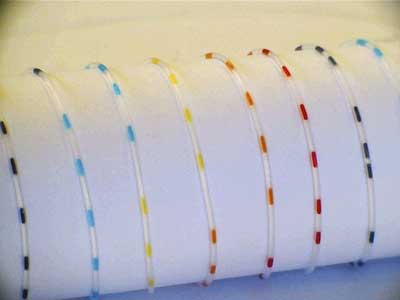| Posted: Jul 03, 2017 |
'Micro drop' chemical reactors are helping to revolutionize scientific experiments
(Nanowerk News) Science is getting smaller. From two-dimensional new materials to nano-robots, many of the latest advances are being made at scales impossible to see with the human eye.
|
|
The latest technique to shake things up at the micro level is a way to trap and study individual living cells to try to understand why they malfunction when diseased. Until now, scientists have done this with electrode “microtraps” (Biomedical Microdevices, "Microtrap electrode devices for single cell trapping and impedance measurement") and highly complex networks of channels carved into plastic chips (Lab on a Chip, "Monolithic Microfabricated Valves and Pumps by Multilayer Soft Lithography").
|
|
But now there’s a way to analyse up to millions of cells simultaneously by putting them inside tiny water-in-oil droplets not much bigger than the cells themselves (Lab on a Chip, "Formation of droplets and bubbles in a microfluidic T-junction-scaling and mechanism of break-up"). This could massively speed up efforts to identify diseased cells, find new drug molecules or new ways to diagnose disease ((Lab on a Chip, "Microdroplets: a sea of applications?").
|
 |
| Each droplet represents an individual reaction vessel. (Image: Fabrice Gielen)
|
|
The days when scientists carried out experiments by mixing chemicals in large glass flasks are long gone. Nowadays, tests are performed in trays punctuated by a number of “microwell” holes that mean just a few microlitres (millionths of a litre) of each sample is needed. The difficulty with going much smaller is that it’s hard to move liquid around at this scale because really tiny drops tend to clump together or evaporate (Lab on a Chip, "Dynamics of microfluidic droplets").
|
|
Although the potential of encapsulating single cells was identified as early as the 1950s (Nature, "Antibody Production by Single Cells"), the droplet field has really picked up pace with the emergence of fabrication technologies borrowed from the semiconductor industry.
|
|
The microdroplet solution is to separate and protect each picolitre (one trillionth of a litre) drop of water by wrapping it in oil. To do this, you feed the water and oil through tiny tubes in a “microfluidic” device and force them to meet at a cross junction where they combine into individual microdroplets. This can create many thousands of identical tiny chemical reactors a second (ACS Nano, "Ultrarapid generation of femtoliter microfluidic droplets for single-molecule-counting immunoassays").
|
|
Other microfluidic devices can be used to combine, split or sort the droplets, just as a scientist might do at a larger scale with a pipette (Current Opinion in Chemical Biology, "Exploring sequence space in search of functional enzymes using microfluidic droplets"). Specially formulated chemicals at the interface between the water and oil keep the droplets stable for days at a time (Nature Communications, "Controlling molecular transport in minimal emulsions").
|
Finding a cellular needle in a haystack
|
|
Droplets are an attractive proposition for tackling needle-in-a-haystack problems, such as isolating very rare cells with a unique mutation or molecular make-up. For example, cells from a tumour can sometimes break off and circulate through the bloodstream, potentially causing cancer elsewhere in the body (metastasis). Finding a way to detect these circulating tumour cells (CTCs) would essentially provide a blood test update on the state of a patient’s cancer. But they are very hard to find because they exist at concentrations as low as one per 10 ml of blood (Nature Reviews Cancer, "Challenges in circulating tumour cell research"). Using a microdroplet technique could allow doctors to quickly comb through the cells from a patient’s blood sample to find a CTC (Molecular Oncology, "Droplet Digital PCR of Circulating Tumor Cells From Colorectal Cancer Patients Can Predict KRAS Mutations Before Surgery").
|
|
Microdroplet techniques can even help confine DNA molecules together with the proteins produced by specific genes, such as biocatalysts or enzymes that help enable certain chemical reactions in a living organism. This means we can find rare DNA mutations that result in more efficient biocatalysts, a process called directed evolution (PNAS, "Ultrahigh-throughput–directed enzyme evolution by absorbance-activated droplet sorting (AADS)"). This is helpful because many biocatalysts are responsible for reactions needed for industrial processes, from washing using detergent powders to making biofuels (Current Opinion in Chemical Biology, "Exploring sequence space in search of functional enzymes using microfluidic droplets").
|
|
Today, the process of screening gene libraries with millions of encoded members is becoming more and more routine. Another promising application is to use environmental samples in the search for molecules that could be used as antibiotics or anti-cancer agents (Nature Communications, "Ultrahigh-throughput discovery of promiscuous enzymes by picodroplet functional metagenomics"). Likewise, researchers can assess collections of antibodies with the hope of finding one that can function as a drug (PNAS, "Functional single-cell hybridoma screening using droplet-based microfluidics").
|
|
Microdroplet techniques do have their limits. For example, small molecules can sometimes diffuse through the oil phase making droplets in effect leaky compartments. Yet there are still many potential advances to be made. For example, one can envision truly personalised medicine where many different drugs are rapidly tested against many different patient cells to find which one is best to prescribe. Microdroplets have had just a decade of use. Think of what they could achieve in the future.
|

